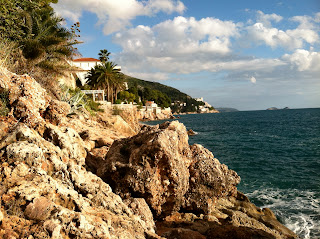SPLIT: A Day with the Emperor
We pick up my chronicles with my day in Split. I think I would have been much more impressed with Split if
I had visited on a day other than November 1. Because All Saints Day is a holiday
all across Croatia, the two coolest and biggest things in Split (the Cathedral
and palace basement halls) were closed on the day I visited. Thus, I spent my
day wandering through the Old City, exploring as many sites as I could without
actually going inside anywhere. I did get to see a segment of the basements, where the marketplace is, and that was pretty cool, but I sadly didn't get to tour the older, supposedly cooler parts. Oh well.

One thing I will say, Split is a city full of surprises. It’s built on the site of Diocletian’s palace, but only certain parts of the palace are still intact. The rest of the space was converted into residences for the city’s rapidly expanding population in the years since Venetian rule ended. What we’re left with now is an interesting mix of roman ruins, baroque palaces, and ugly 70s architecture.
 |
| Baroque architecture in the main square |
Because of the randomness of Split, you can turn a corner and never know what you're going to find! For example, in my period of aimless wandering, I turned down a narrow alleyway and
found this:
I like that a lot about this city. It, like Zadar, is walled
and on the coast, but its walls are much more integrated into the more recent
buildings than in Zadar, where the wall was completely intact. On the promenade
by the water, you can see the different layers of construction from different
periods.
Luckily the weather was quite nice on the day I visited, so
when I had exhausted my city-wandering possibilities (there’s only so many
times you can get lost in the same confusing labyrinth of tiny alleys) I sat
out on the lovely harbor promenade and read a book, enjoying the clue skies and
sunshine that had been previously unexpectedly absent from my trip.
 |
| Renaissance-era town hall, also in the main square |
DUBROVNIK: The "OH MY GOODNESS THIS IS TOO BEAUTIFUL" City
The first thing I did in Dubrovnik was walk around the entire city atop the old wall, that still stands completely intact (thanks to lots of renovations). I was able to walk the whole perimeter and it was incredible—it provided wonder after wonder after wonder. Here’s a video of a small segment of my walk:
And a video in which I talk about my first day in Dubrovnik:
 |
| View of the harbor from atop the walls |
In addition to the walk around the walls of Dubrovnik, which
was probably my favorite part of the whole trip, I enjoyed other city sites as
well! One favorite was the Rector’s Palace, which is a Renaissance palace that
has been converted into a museum. The architecture itself was pretty cool, with
a lovely courtyard in the middle and rooms sprawling off to each side, each
with a different exhibit. One had baroque furniture, another held Renaissance
paintings, and another had medieval church icons. My favorites were the section
on weaponry, with actual swords and armor from different time periods, and a
war photograph exhibit with incredible pictures of Dubrovnik from 1991. Seeing
the streets and plazas that are now packed with locals and tourists completely
abandoned, boarded up or destroyed was a very sobering sight. And to think this
is all so recent gives it another chilling quality.
 |
| Rector's Palace at twilight |
 |
| View from the balcony at the place I stayed |
My other favorite Dubrovnik site was the Jewish Museum.
Apparently Dubrovnik was at one point home to a small but mighty Jewish
population! Who knew? There’s a museum with Torah scrolls, mantels, Chanukah menorahs,
seder plates, prayer shawls, and other possessions of the city’s Jewish
residents from over the years. There was even a letter from Moses Montefiore
thanking the Jewish of Dubrovnik for their birthday greetings, which I thought
was cute. There were also copies of the proclamations declaring all Jews in
Croatia to identify themselves and cease gatherings and assembles—a sobering
reminder of the extent of the Holocaust’s spread. This museum was on the second
floor of an ordinary house in the old city, and the third floor holds the
synagogue! It’s a very small space, but just marvelously put together. The
ceiling simply but beautifully painted and the chairs, made of gorgeous dark
wood, surround the room along the walls so you can imagine everyone sitting
almost in a circle facing each other during the service. Ther wasn’t anything
especially different or unique about the synagogue but for some reason it was
very striking and moving. I loved it. Sadly, no pictures, though.
 |
| Market square with statue of Ivan Gundulic, beloved Dubrovnik poet |
The rest of my time in Dubrovnik was spent on the beach,
soaking up the sun, or people watching in the main square. The city definitely
hs a relaxed Mediterranean feel to it, which I really loved a lot. I HIGHLY
recommend Dubrovnik. It’s a must for anyone visiting Croatia!!
Thanks for reading these two endless posts! It was a really great trip, and I hope you all get the chance to check Croatia out sometime!! The gelato is wonderful.




















.jpg)
.jpg)






















